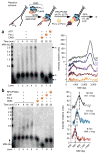Mechanism of asymmetric polymerase assembly at the eukaryotic replication fork
- PMID: 24997598
- PMCID: PMC4482249
- DOI: 10.1038/nsmb.2851
Mechanism of asymmetric polymerase assembly at the eukaryotic replication fork
Abstract
Eukaryotes use distinct polymerases for leading- and lagging-strand replication, but how they target their respective strands is uncertain. We reconstituted Saccharomyces cerevisiae replication forks and found that CMG helicase selects polymerase (Pol) ɛ to the exclusion of Pol δ on the leading strand. Even if Pol δ assembles on the leading strand, Pol ɛ rapidly replaces it. Pol δ-PCNA is distributive with CMG, in contrast to its high stability on primed ssDNA. Hence CMG will not stabilize Pol δ, instead leaving the leading strand accessible for Pol ɛ and stabilizing Pol ɛ. Comparison of Pol ɛ and Pol δ on a lagging-strand model DNA reveals the opposite. Pol δ dominates over excess Pol ɛ on PCNA-primed ssDNA. Thus, PCNA strongly favors Pol δ over Pol ɛ on the lagging strand, but CMG over-rides and flips this balance in favor of Pol ɛ on the leading strand.
Conflict of interest statement
The authors declare no competing financial interests.
Figures







Comment in
-
Delivering nonidentical twins.Nat Struct Mol Biol. 2014 Aug;21(8):649-51. doi: 10.1038/nsmb.2852. Epub 2014 Jul 6. Nat Struct Mol Biol. 2014. PMID: 24997601 Free PMC article.
Similar articles
-
Quality control mechanisms exclude incorrect polymerases from the eukaryotic replication fork.Proc Natl Acad Sci U S A. 2017 Jan 24;114(4):675-680. doi: 10.1073/pnas.1619748114. Epub 2017 Jan 9. Proc Natl Acad Sci U S A. 2017. PMID: 28069954 Free PMC article.
-
CMG helicase and DNA polymerase ε form a functional 15-subunit holoenzyme for eukaryotic leading-strand DNA replication.Proc Natl Acad Sci U S A. 2014 Oct 28;111(43):15390-5. doi: 10.1073/pnas.1418334111. Epub 2014 Oct 13. Proc Natl Acad Sci U S A. 2014. PMID: 25313033 Free PMC article.
-
Reconstitution of a eukaryotic replisome reveals suppression mechanisms that define leading/lagging strand operation.Elife. 2015 Apr 14;4:e04988. doi: 10.7554/eLife.04988. Elife. 2015. PMID: 25871847 Free PMC article.
-
The Eukaryotic CMG Helicase at the Replication Fork: Emerging Architecture Reveals an Unexpected Mechanism.Bioessays. 2018 Mar;40(3):10.1002/bies.201700208. doi: 10.1002/bies.201700208. Epub 2018 Feb 6. Bioessays. 2018. PMID: 29405332 Free PMC article. Review.
-
Balancing eukaryotic replication asymmetry with replication fidelity.Curr Opin Chem Biol. 2011 Oct;15(5):620-6. doi: 10.1016/j.cbpa.2011.07.025. Epub 2011 Aug 19. Curr Opin Chem Biol. 2011. PMID: 21862387 Free PMC article. Review.
Cited by
-
The unstructured linker of Mlh1 contains a motif required for endonuclease function which is mutated in cancers.Proc Natl Acad Sci U S A. 2022 Oct 18;119(42):e2212870119. doi: 10.1073/pnas.2212870119. Epub 2022 Oct 10. Proc Natl Acad Sci U S A. 2022. PMID: 36215471 Free PMC article.
-
New insights into the mechanism of DNA mismatch repair.Chromosoma. 2015 Dec;124(4):443-62. doi: 10.1007/s00412-015-0514-0. Epub 2015 Apr 11. Chromosoma. 2015. PMID: 25862369 Free PMC article. Review.
-
Structure of the polymerase ε holoenzyme and atomic model of the leading strand replisome.Nat Commun. 2020 Jun 22;11(1):3156. doi: 10.1038/s41467-020-16910-5. Nat Commun. 2020. PMID: 32572031 Free PMC article.
-
Cryo-EM of dynamic protein complexes in eukaryotic DNA replication.Protein Sci. 2017 Jan;26(1):40-51. doi: 10.1002/pro.3033. Epub 2016 Sep 14. Protein Sci. 2017. PMID: 27589669 Free PMC article. Review.
-
Reconstitution of a eukaryotic replisome reveals the mechanism of asymmetric distribution of DNA polymerases.Nucleus. 2016 Jul 3;7(4):360-8. doi: 10.1080/19491034.2016.1205774. Nucleus. 2016. PMID: 27416113 Free PMC article. Review.
References
-
- Méndez J, Stillman B. Perpetuating the double helix: molecular machines at eukaryotic DNA replication origins. BioEssays. 2003;25:1158–1167. - PubMed
-
- Benkovic SJ, Valentine AM, Salinas F. Replisome-mediated DNA replication. Annu Rev Biochem. 2001;70:181–208. - PubMed
-
- Kornberg A, Baker TA. DNA Replication. W.H. Freeman; New York: 1992.
Publication types
MeSH terms
Substances
Grants and funding
LinkOut - more resources
Full Text Sources
Other Literature Sources
Molecular Biology Databases
Miscellaneous

